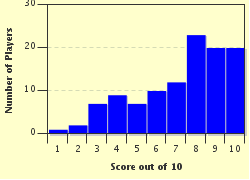Quiz Answer Key and Fun Facts
1. Turn a South American flag into a North American flag in three short moves:
1. Take the flag of Peru (pictured) and remove the coat of arms.
2. Widen the central white band at the expense of the red bands either side.
3. Add a leaf synonymous with this new country.
What country does the new flag belong to?
2. A number of countries feature Scandinavian crosses:
1. Take Norway's flag (pictured). Change the field colour to the same blue of the cross.
2. Now change the blue cross to the same colour as the red field.
Which nearby country's flag do you now have?
3. Many national flags contain Union Jacks:
1. Take Australia's flag and remove two particular stars from the six displayed.
2. Change the remaining six point stars to five point stars.
3. Change the star colour to red.
4. Now put a white border around all four stars.
Voila! What country's flag have you now made?
4. Now we are moving from Soccer World Cup Winner to Soccer Euro 2004 winner:
1. Take Uruguay's flag and remove the sun.
2. Now flip the colours (Make all blue parts white and all white parts blue).
3. Add a white cross to the blue canton (top left portion).
What European flag have you just created?
5. This time we need three flags from three changes, please:
1. Take Indonesia's flag, flip it clockwise 180 degrees - New Flag 1.
2. Now take New Flag 1 and rotate it clockwise 180 degrees - New Flag 2.
3. Take New Flag 2 and add a white crescent and five, five pointed stars to the canton - New Flag 3.
What the the three respective countries represented by New Flags 1, 2 & 3?
6. Diagonal crosses are called saltires. They appear on a few national flags:
1. Change the saltire colour from white to yellow. Narrow the width a little.
2. Change the left and right triangles from blue to black.
3. Change the top and bottom triangles from blue to green.
You can see a Ian fleming connection between these two flags. What is the new country's flag you are now holding?
7. The Pan-African colours are green, red and yellow but let's break the mould:
1. Take the flag of Mali and swap the positions of the green and yellow bands.
2. Now rotate the flag 90 degrees clockwise. Stretch it out a bit to make the conventional rectangular shape.
Which non-African flag do you have now?
8. Okay, It's getting a bit trickier now:
1. Take the Estonian flag and narrow the black band by about half.
2. Split the white band in two and place a thinner white band either side of the black band.
3. Where the white band was, replace it with sky blue.
4. Change the top blue band to match the same blue as the new lower band.
Which African country's flag have you now made?
9. Staying within Africa:
1. Take the flag of the Democratic Republic of Congo, remove the star.
2. Narrow the red diagonal, making the yellow bordering diagonals slightly wider.
3. Change the red diagonal to black.
4. Change the upper blue triangle to green.
5. For completeness, adjust the positions of the diagonals a little.
Which neighbouring African nation's flag are you now looking at?
10. Now we need to cut effectively a flag in half (*gasp*):
1. Take the Ugandan flag and remove the crested crane and central white disc.
2. Rearrange the six bands so the same colours are adjacent, making three fatter bands in the same order.
3. Rotate the flag 90 degrees COUNTER-clockwise. Adjust to make a long rectangle in the traditional flag dimensions.
Which European flag are you know holding?
Source: Author
1nn1
This quiz was reviewed by FunTrivia editor
trident before going online.
Any errors found in FunTrivia content are routinely corrected through our feedback system.

